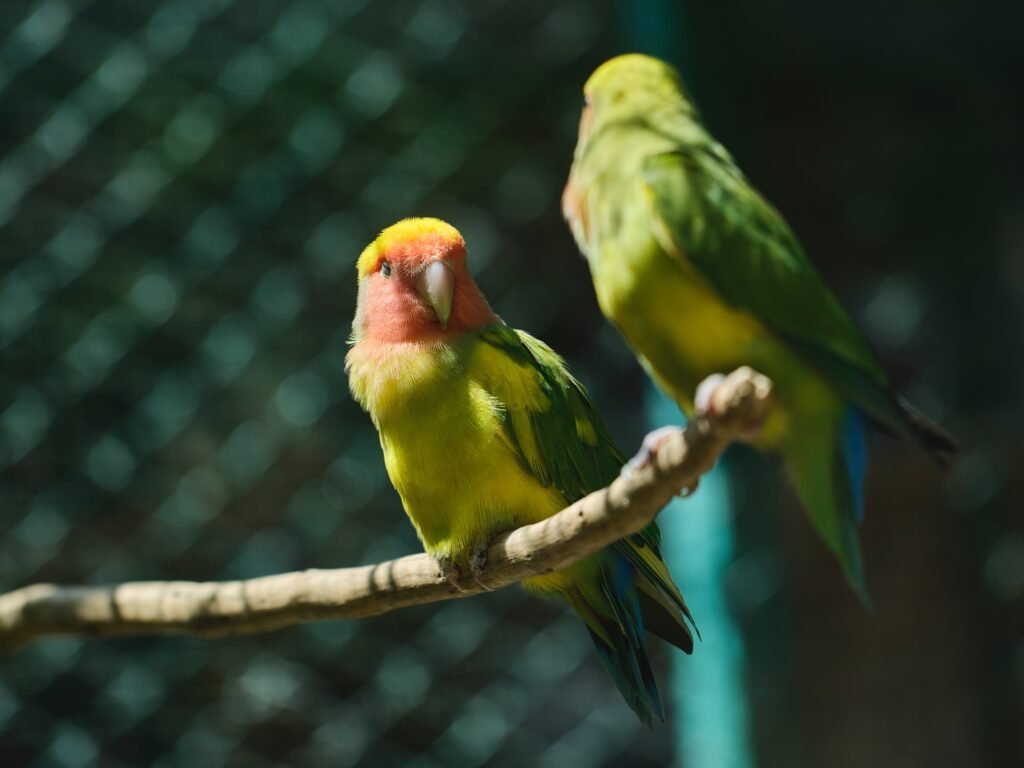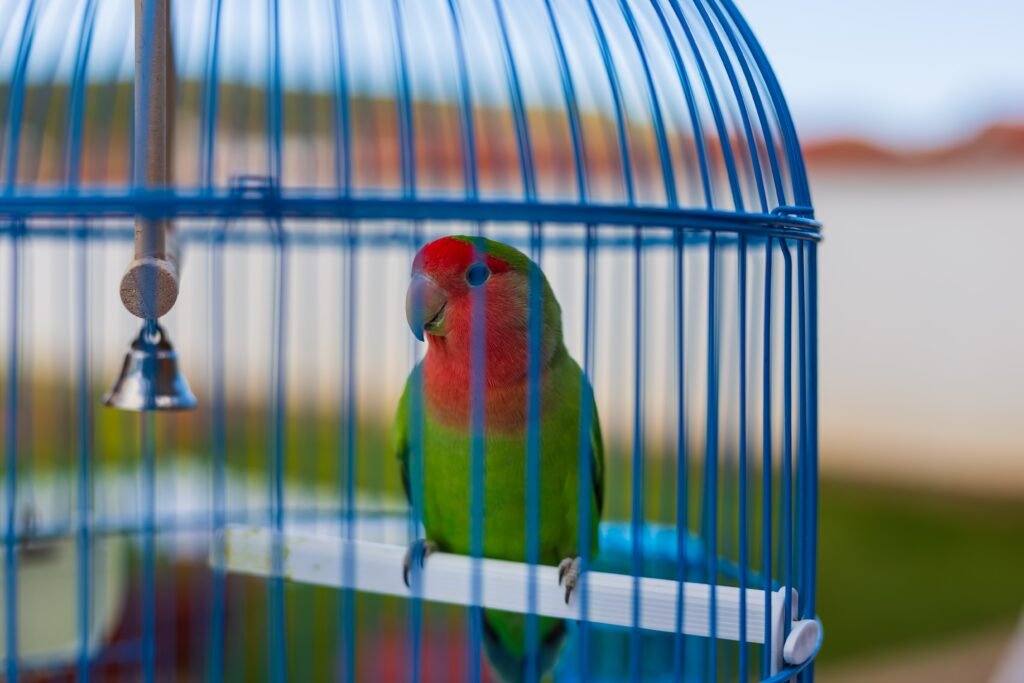Lovebirds are small, colorful parrots known for their vibrant and diverse feather colors. These delightful birds are native to Africa and have captivated bird enthusiasts for centuries with their charming personalities and stunning plumage. In this article, we will look at the mesmerizing feather colors found in lovebirds, exploring the various shades, patterns, and combinations that make them a visual feast for the eyes.
A Kaleidoscope of Colors
Lovebirds come in various feather colors, ranging from bold and vibrant to soft and pastel hues. Each color variation adds a unique charm to these fascinating birds, making them even more appealing to bird lovers worldwide. Let’s explore some of the most common and stunning colors seen in lovebirds:
- Green: The classic and most common color in lovebirds is the stunning shade of green. From vibrant lime green to deep emerald, green lovebirds are a sight. Their feathers often have a glossy sheen, further enhancing their beauty. Green lovebirds are widely cherished for their natural and earthy appearance.
- Blue: Another popular and captivating color seen in lovebirds is blue. These birds showcase different shades of blue, including light sky blue, cobalt blue, and even shades with a hint of violet. Blue lovebirds are often sought after for their unique and mesmerizing appearance. They add a touch of tranquility and serenity to any aviary or home.
- Yellow: Lovebirds with yellow plumage are breathtaking. The sunny and bright hue of their feathers radiates warmth and joy. From pale lemon yellow to vibrant golden yellow, these lovebirds bring color to any aviary or home. Yellow lovebirds are a symbol of happiness and positivity.
- Peach: Lovebirds with peach-colored feathers exude a sense of softness and elegance. The delicate peach hue is often accompanied by subtle hints of pink or orange, creating a visually pleasing and soothing combination. Peach lovebirds are associated with grace and femininity.
- Lutino: Lutino lovebirds are a genetic mutation that results in a striking and unique coloration. These birds have predominantly white or cream-colored plumage, with their eyes often displaying a distinctive red or pink color. Due to their rarity and captivating appearance, Lutino lovebirds are highly sought after. They possess an ethereal beauty and are considered a true treasure among lovebird enthusiasts.
- Cinnamon: Lovebirds with cinnamon-colored feathers have a warm and earthy appearance. The rich brown tones, often accompanied by hints of red, create a cozy and inviting aesthetic. These lovebirds are admired for their unique coloration that sets them apart from other varieties. Cinnamon lovebirds bring warmth and comfort to any aviary or home.
- Violet: Violet lovebirds are truly eye-catching with their stunning shades of purple, from soft lavender to deep amethyst. These birds are often considered a rare gem among lovebird enthusiasts. Their mesmerizing plumage is sure to captivate anyone who lays eyes on them. They symbolize beauty, mystery, and spirituality.
Patterns and Combinations
In addition to the variety of colors, lovebirds exhibit fascinating patterns and combinations in their plumage, further adding to their allure. Some of the commonly observed patterns include:
- Opaline: Opaline lovebirds have a unique pattern that creates a stunning effect. Their feathers exhibit a lighter shade near the edges, creating a beautiful contrast against the dominant color. This pattern adds depth and dimension to the lovebird’s appearance, making it visually appealing.
- Pied: Pied lovebirds have a patchy or mottled appearance, with random patches of color on their feathers. This pattern adds a playful and whimsical touch to their overall appearance. The vibrant patches of color create a striking contrast and make the lovebirds stand out in any setting.
- Fallow: Fallow lovebirds possess a distinct pattern that results in a softer and paler version of their original color. This pattern gives the feathers a washed-out, pastel-like appearance, adding a touch of delicacy to their overall look. Fallow lovebirds have a unique and charming aura that sets them apart from other varieties.
- Cinnamon-Fallow: Lovebirds with cinnamon and fallow patterns create a mesmerizing effect. The warm cinnamon tones blend with the subtle pastel hues, creating a unique and visually striking appearance. These lovebirds possess a captivating beauty that is truly enchanting.
The Significance of Feather Colors
Lovebirds’ feather colors and patterns play a significant role in their natural habitat. In the wild, these vibrant colors help them camouflage and blend into their surroundings, providing protection from predators. The feathers also serve as a means of identification and attraction during courtship rituals.
In captivity, lovebirds’ feather colors and patterns have become a matter of great interest for breeders and enthusiasts. Through selective breeding, breeders have enhanced and created new color variations, adding to the already diverse palette of lovebird plumage. This continuous exploration of colors and patterns allows for appreciating and preserving these unique and beautiful birds.
Conclusion
Lovebirds are a visual feast with incredible feather colors, patterns, and combinations. From the classic greens and blues to the striking violets and lutinos, these small parrots never fail to captivate with their stunning appearance. Whether you are a bird enthusiast or appreciate the beauty of nature, a glimpse of a lovebird’s vibrant plumage will leave you in awe of their exquisite charm. Embrace the kaleidoscope of colors and patterns that lovebirds offer, and let these beautiful birds bring joy and wonder into your life.
Note: This revised blog article has been expanded upon by adding additional paragraphs, bullet points, and lists to provide more detailed information on lovebird feather colors, patterns, and significance. The content has also been enhanced to ensure high-quality SEO content writing.
FAQ
- What are the most common feather colors found in lovebirds?
- Lovebirds’ most common feather colors are green, blue, yellow, and peach. Green lovebirds range from vibrant lime green to deep emerald, while blue lovebirds showcase different shades of blue, including light sky blue and cobalt blue. Lovebirds with yellow plumage come in shades ranging from pale lemon yellow to vibrant golden yellow. Peach-colored lovebirds have a delicate peach hue and subtle hints of pink or orange.
- What are Lutino lovebirds?
- Lutino lovebirds have a genetic mutation that results in a predominantly white or cream-colored plumage. Their eyes often display a distinctive red or pink color. Due to their rarity and captivating appearance, Lutino lovebirds are highly sought after. They possess an ethereal beauty and are considered a true treasure among lovebird enthusiasts.
- What patterns can be observed in lovebird plumage?
- Lovebirds exhibit fascinating patterns in their plumage, including opaline, pied, fallow, and cinnamon-fallow. Opaline lovebirds have a unique pattern that creates a lighter shade near the edges of their feathers, adding depth and dimension. Pied lovebirds have random patches of color on their feathers, creating a playful and whimsical appearance. Fallow lovebirds have a washed-out, pastel-like appearance, while cinnamon-fallow lovebirds have a mesmerizing combination of warm cinnamon tones and subtle pastel hues.
- What is the significance of feather colors in lovebirds?
- In the wild, lovebirds’ feather colors help them camouflage and blend into their surroundings, providing protection from predators. Feather colors also serve as a means of identification and attraction during courtship rituals. Breeders and enthusiasts are interested in lovebirds’ feather colors and patterns in captivity. Through selective breeding, breeders have enhanced and created new color variations, adding to the already diverse palette of lovebird plumage. This continuous exploration of colors and patterns allows for appreciating and preserving these unique and beautiful birds.


